英语语言学 第六章
- 格式:ppt
- 大小:2.05 MB
- 文档页数:55
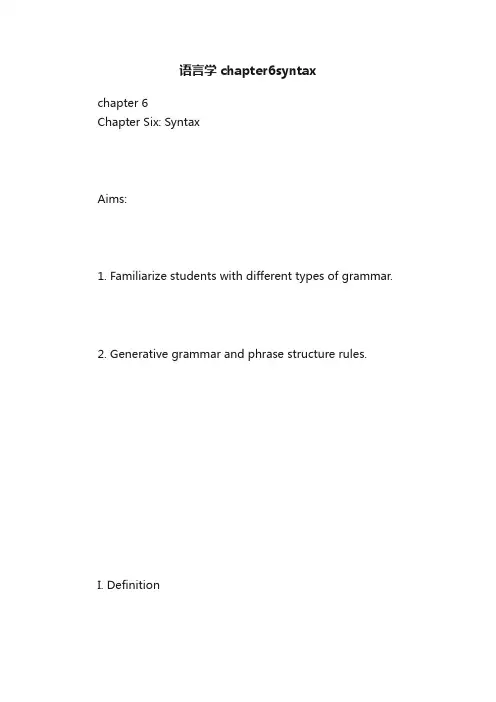
语言学chapter6syntaxchapter 6Chapter Six: SyntaxAims:1. Familiarize students with different types of grammar.2. Generative grammar and phrase structure rules.I. DefinitionSyntax, derived originally from Greek, is made up of two morphemes: syn-(meaning together) and –tax (to arrange), hence the literal meaning “a setting out together” or “arrangement”. In linguistics, it refers to the study of the rules governing the way words are combined to form sentences in a language, or simply, the study of the formation of sentences.We have already considered two levels of description used in the study of language (phonetic and morphological). With these descriptions, we could characterize all the words/phrases of a language in terms of their phonetic and morphological make-up.However, we have not yet accounted for the fact that these words can only be combined in a limited number of patterns. We recognize that the phrase the lucky boys is a well-formed piece of English, but that the following two phrases are not at all well-formed.*boys the lucky *lucky boys theSo we need a way of describing the structure of phrases andsentences which will account for all of the grammatical sequences and rule out all the ungrammatical sequences. Providing such an account involves us in the study of grammar.II. Types of grammarl Traditional Grammar and the prescriptive approach: Grammar as ‘linguistic etiquette’, i.e. the identification of the best/proper structures to be used;l Structuralism and descriptive approach: Grammar as the study and analysis of the structures found in a language, with the aim of establishing a description of the grammar of a particular language.l Universal grammar and Generative approach: Grammar as a form of internal linguistic knowledge that operates in the appropriate production and comprehension of natural languages.2.1 Traditional GrammarTraditionally, a sentence is seen as a sequence of words. Whether a word can occupy a certain position in a sentence depends on its grammatical category rather than its meaning. Therefore, the study of sentence formation involves a great deal of the study of the word in terms of parts of speech, subject predicate, number, gender and case. etcThese categories can be discussed in isolation, but their role in describing language structure becomes clearer when we consider them is terms of agreement. For example, we say that the verb likes ‘agrees with’ the noun boy in the sentence The boy likes his dog. This agreement is partially based on the category of number, that is, whether the noun is singular or plural. It is also based on the category of person, which covers the distinctions of first person, second person and third person. The different forms of English pronouns are usually described in terms of person and number, in that we have firstperson singular (I), second person singular (you), third person singular (he, she, it), first person plural (we) and so on. So, in the sentence The boy likes his dog, we have a noun boy, which is third person singular, and the verb likes ‘agrees with” the noun.In addition, the form of the verb must also be described in terms of another category, that is of tense. In this case, the verb (likes) is in the present tense, which is distinguished from the past tense (liked). The sentence is also in the active voice, with the boy doing the liking. An alternative is the passive voice in which the liking is done to the boy, as in The boy is liked by his dog.Our final category is that of gender, which helps us describe the agreement between boy and his in our example sentence. In English, we have to describe this relationship in terms of natural gender, mainly derived from a biological distinction between male and female. The agreement between Boy and his is based on a distinction English makes between reference to male entities (he, his), female entities (she, her), and sexless entities, or animals when the sex of the animal is irrelevant (it its).Since traditional grammar is based on the rules of Latin, it is quite another thing to go on to claim that the structure of English sentences should be like the structure of sentences in Latin. Theview of grammar as a set of rules for the ‘proper’ use of a language may be best characterized as the prescriptive approach.2.2 StructuralismIt may be that using a well-established grammatical description of Latin is a useful guide for studying some languages (e.g. Italian or Spanish), is less useful for others (e.g. English), and may be absolutely misleading if you want to describe some non-Europe languages. This last point became clear to these linguists who wanted to describe the structure of North American Indian languages at the end of the nineteenth century. The categories and rules which were appropriate for Latin grammar just did not seem to fit the Indian languages encountered. As a consequence, throughout the present century, a rather different approach has been taken. Analysts collect samples of the language they are interested in and attempt to describe the regular structures of the language as it is used, not according to some view of how it should be used. This is called the descriptive approach and it is the basis of most modern attempts to characterize the structure of different languages.IC analysisLet’s take a look at the following sentence:The dog followed the boy.We can identify five words (constituents). How do those five constituents go together to form constituents at the phrase level?Structural linguists realize that a sentence does not only have a linear structure, consisting of individual words one after another in a line; they also have a hierarchical structure, made up of layers of word groups. So the analysis of a sentence in terms of its immediate constituent --- word groups (or phrases), which are in turn analyzed into the immediate constituents of their own and the process goes on until the ultimate constituents are reached is called IC analysis.So the above can be diagramed like:(((The) (dog)) ((followed) ((the) (boy)))). or more clearly in labeled tree diagram.2.3 Generative grammarSince the 1950s, particularly developing from the work of the American linguist Noam Chomsky, there have been attempts to produce a particular type of grammar which would have a very explicit system of rules specifying what combinations of basic elements would result in well-formed sentences. This explicit system of rules, it was proposed, would have much in common with the types of rules found in mathematics. This mathematical point of view helps to explain the meaning of the terms generative, which is used to describe this type of grammar. If you have an algebraic expression like 3x+2y, and you can give x and y the value of any whole number, then that simple algebraic expression can generate an endless set of values, by following the simple rules of arithmetic. Then there must be a set of explicit rules which yield those sentences. Such a set of explicit rules is a generative grammar.2.3.1 Some properties of the generative grammarA grammar of this type must have a number of properties, which can be described in the following terms.a. “all and only” criterion: The grammar will generate all the well-formed sentences of the language and fail to generate any ill-formed structures.b. It has limited number of rules, but it can generate an infinite number of well-formed structures.c. recursion: The rules can be applied more than once in generating a structure. Basically, the grammar will have to capture the fact that a sentence can have another sentence inside it, or a phrase can have another phrase of the same type inside it.e.g. This is the dog that chased the cat that killed the rat…The book was on the table near the window in the hallway beside the…2.3.2 Deep and surface structureThis grammar should also be capable of revealing the basis of two other phenomena: first, how some superficially distinct sentences are closely related, and second how some superficially similar sentences are in fact distinct.For example, Charlie broke the windowThe window was broken by Charlie.The difference between them (active vs. passive) is in their surface structure that is the syntactic form they take as actual English sentence. However, this difference in superficial form disguises the fact that the two sentences are very closely related even identical, at some less ‘superficial’ level. This other ‘un derlying’ level, where the basic components share by the two sentences would be represented, has been called their deep structure.In his book Syntactic Structure publish in 1957, Chomsky proposed a linguistic model consisting of three components:2.3.3Transformational rulesPhrase structure rules generate the deep structure of the sentence. The sentences we actually see and hear are the surface structures. From deep structure to surface it should undergo transformations. In the following examplesi. George helped Mary yesterday.ii. Yesterday George helped Mary.We can think of the yesterday element as having been ‘moved to the beginning of the sentence in ii. In order to do this, we need a set of rules which will change or move constituents in the structures derived from the phrase structure rules. these are called transformational rules. Essentially what they do is take a branch of the tree away from one part of the tree diagram, and attach it to a different part. Here is an example of a movement transformation.The rules would, of course, specify which constituents can be move, from where and to where.Let’s take a look at a verb-particle construction.i. Doobie picked up the magazine.ii. Doobie picked the magazine up.We intuitively recognize that these two sentences must come from a single underlying source. Let us propose a single tree diagram source which produces a string of elements. Like: NP Verb Particle NP Under circumstances like these, let us then propose the optional transformation called ‘Particle Movement’, which takes that description and yields the structural change to NP Verb NP Particle.By using this simple transformational rule, we have provided the means for explicitly relating the two structures in sentences i and ii above as ‘surface’ variations of a single underlying structure. It may not seem much, but this type of transformational analysis solved a number of tricky problems for previous syntactic descriptions.Exercises:0. In what ways are these expressions ambiguous?a. An American history teacher.b. Flying planes can be dangerous.c. The parents of the bride and the groom were waiting.1. Can you provide four ‘superficially distinct’ sentences which would each have the same ‘underlying’ structure as one of the following sentences?a. Lara was arrested by the police.b. She took her coat off.c. Someone stole my bicycle.d. I told him to turn down the volume.3. Which of the following expressions would be generated by this phrase structure rule: NP →Art (Adj) N ?a. a radiob. the rusty carc. a new studentd. the screwdriver4. Which of the following structures can be changed via the Particle Movement transformation?a. He put down his glass.b. She threw away her dress.c. he pulled off his shirt.d. They jumped in the pool.5. Please give tree diagrams of the following sentences.a. The boy helped George today.b. George saw the dog with Mary.c. The boy saw the man with the telescope.d. The very old teachers you met yesterday greatly fear the blackbirds.。
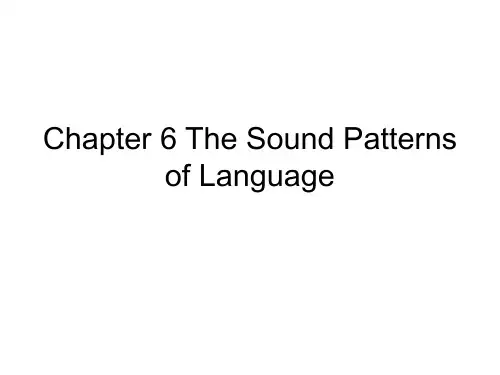
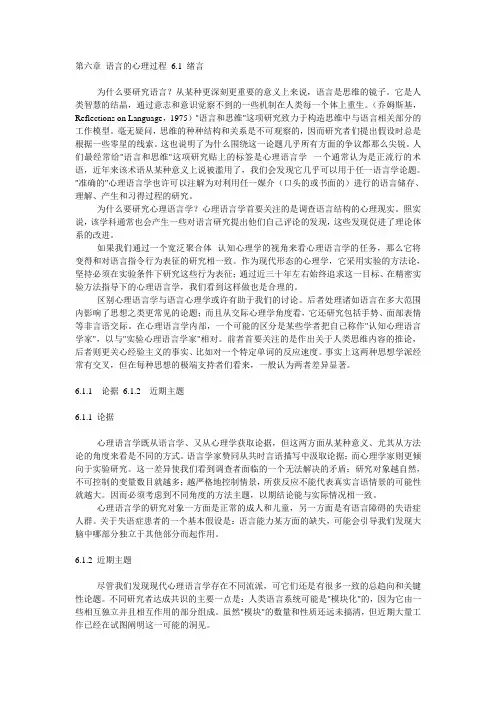
第六章语言的心理过程6.1 绪言为什么要研究语言?从某种更深刻更重要的意义上来说,语言是思维的镜子。
它是人类智慧的结晶,通过意志和意识觉察不到的一些机制在人类每一个体上重生。
(乔姆斯基,Reflections on Language,1975)"语言和思维"这项研究致力于构造思维中与语言相关部分的工作模型。
毫无疑问,思维的种种结构和关系是不可观察的,因而研究者们提出假设时总是根据一些零星的线索。
这也说明了为什么围绕这一论题几乎所有方面的争议都那么尖锐。
人们最经常给"语言和思维"这项研究贴上的标签是心理语言学--一个通常认为是正流行的术语,近年来该术语从某种意义上说被滥用了,我们会发现它几乎可以用于任一语言学论题。
"准确的"心理语言学也许可以注解为对利用任一媒介(口头的或书面的)进行的语言储存、理解、产生和习得过程的研究。
为什么要研究心理语言学?心理语言学首要关注的是调查语言结构的心理现实。
照实说,该学科通常也会产生一些对语言研究提出他们自己评论的发现,这些发现促进了理论体系的改进。
如果我们通过一个宽泛聚合体--认知心理学的视角来看心理语言学的任务,那么它将变得和对语言指令行为表征的研究相一致。
作为现代形态的心理学,它采用实验的方法论,坚持必须在实验条件下研究这些行为表征;通过近三十年左右始终追求这一目标、在精密实验方法指导下的心理语言学,我们看到这样做也是合理的。
区别心理语言学与语言心理学或许有助于我们的讨论。
后者处理诸如语言在多大范围内影响了思想之类更常见的论题;而且从交际心理学角度看,它还研究包括手势、面部表情等非言语交际。
在心理语言学内部,一个可能的区分是某些学者把自己称作"认知心理语言学家",以与"实验心理语言学家"相对。
前者首要关注的是作出关于人类思维内容的推论,后者则更关心经验主义的事实、比如对一个特定单词的反应速度。
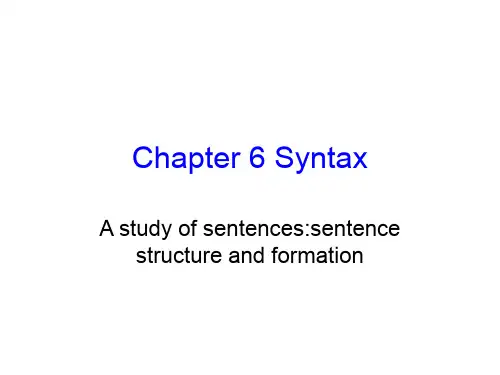
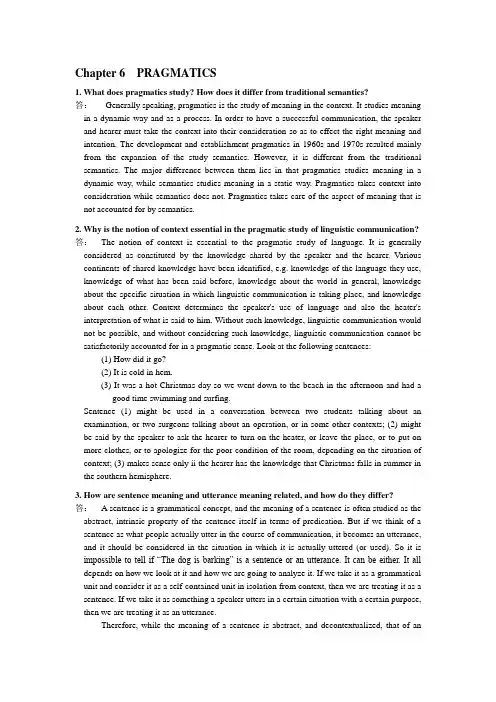
Chapter 6 PRAGMATICS1. What does pragmatics study? How does it differ from traditional semantics?答:Generally speaking, pragmatics is the study of meaning in the context. It studies meaning in a dynamic way and as a process. In order to have a successful communication, the speaker and hearer must take the context into their consideration so as to effect the right meaning and intention. The development and establishment pragmatics in 1960s and 1970s resulted mainly from the expansion of the study semantics. However, it is different from the traditional semantics. The major difference between them lies in that pragmatics studies meaning in a dynamic way, while semantics studies meaning in a static way. Pragmatics takes context into consideration while semantics does not. Pragmatics takes care of the aspect of meaning that is not accounted for by semantics.2. Why is the notion of context essential in the pragmatic study of linguistic communication? 答:The notion of context is essential to the pragmatic study of language. It is generally considered as constituted by the knowledge shared by the speaker and the hearer. Various continents of shared knowledge have been identified, e.g. knowledge of the language they use, knowledge of what has been said before, knowledge about the world in general, knowledge about the specific situation in which linguistic communication is taking place, and knowledge about each other. Context determines the speaker's use of language and also the heater's interpretation of what is said to him. Without such knowledge, linguistic communication would not be possible, and without considering such knowledge, linguistic communication cannot be satisfactorily accounted for in a pragmatic sense. Look at the following sentences:(1) How did it go?(2) It is cold in hem.(3) It was a hot Christmas day so we went down to the beach in the afternoon and had agood time swimming and surfing.Sentence (1) might be used in a conversation between two students talking about an examination, or two surgeons talking about an operation, or in some other contexts; (2) might be said by the speaker to ask the hearer to turn on the heater, or leave the place, or to put on more clothes, or to apologize for the poor condition of the room, depending on the situation of context; (3) makes sense only ii the hearer has the knowledge that Christmas falls in summer in the southern hemisphere.3. How are sentence meaning and utterance meaning related, and how do they differ?答: A sentence is a grammatical concept, and the meaning of a sentence is often studied as the abstract, intrinsic property of the sentence itself in terms of predication. But if we think of a sentence as what people actually utter in the course of communication, it becomes an utterance, and it should be considered in the situation in which it is actually uttered (or used). So it is impossible to tell if “The dog is barking” is a sentence or an utterance. It can be either. It all depends on how we look at it and how we are going to analyze it. If we take it as a grammatical unit and consider it as a self-contained unit in isolation from context, then we are treating it as a sentence. If we take it as something a speaker utters in a certain situation with a certain purpose, then we are treating it as an utterance.Therefore, while the meaning of a sentence is abstract, and decontextualized, that of anutterance is concrete, and context-dependent. The meaning of an utterance is based on sentence meaning; it is the realization of the abstract meaning of a sentence in a real situation of communication, or simply in a context. Now, take the sentence "My bag is heavy" as an example. Semantic analysis of the meaning of the sentence results in the one-place predication BAG (BEING HEA VY). Then a pragmatic analysis of the utterance meaning of the .sentence varies with the context in which it is uttered. For example, it could be uttered by a speaker as a straightforward statement, telling the hearer that his bag is heavy. It could also be intended by the speaker as an indirect, polite request, asking the hearer to help him carry the bag. Another possibility is that the speaker is declining someone's request for help. All these are possible interpretations of the same utterance “M y bag is heavy”. How it is to be underst ood depends on the context in which it is uttered and the purpose for which the speaker utters it.While most utterances take the form of grammatically complete sentences, some utterances do not, and some cannot even be restored to complete sentences.4. Try to think of contexts in which the following sentences can be used for other purposes than just stating facts:a) The room is messy.b) Oh, it is raining!c) The music of the movie is good.d) You have been keeping my notes for a whole week now.答:a) A father entered his son’s room and found it is very messy. Then when he said, “The room is messy,” he was blaming his son for not tidying it up.b) A son asked his father to play with him outside. So when the father said, “Oh, it’s raining”,he meant they couldn’t play outside.c) Two persons just watched a movie and had a discussion of it. One person sai d, “The story ofthe movie is very moving”, so wh en the other person sai d, “The music of the movie is good”, he me ant he didn't think the story of the movie was good.d) A person wanted his notes bac k, so when he said, “you ha ve been keeping my notes for awhole wee k now”, he was demanding the return of his notes.5. According to Austin, what are the three acts a person is possibly performing while making an utterance. Give an example.答:According to Austin's new model, a speaker might be performing three acts simultaneously when speaking: locutionary act, illocutionary act, and perlocutionary act.A locutionary act is the act of uttering words, phrases, clauses. It is the act of conveying literal meaning by means of syntax, lexicon and phonology. An illocutionary act is the act of expressing the speaker’s intention; it is the act performed in saying something. A perlocutionary act is the act performed by or resulting from saying something; it is the consequence of, or the change brought about by the utterance; it is the act performed by saying something. Let's look at an example:You have left the door wide open.The locutionary act performed by the speaker is his utterance of the wo rds “you”, “have”, “door”, “open”, etc. thus expressing what the words literally mean.The illocutionary act performed by the speaker is that by making such an utterance he has expressed his intention of speaking, i.e. asking someone to close the door, or making acomplaint, depending on the context.The perlocutionary act refers to the effect of the utterance. If the hearer gets the speaker's message and sees that the speaker means to tell him to close the door, the speaker has successfully brought about the change in the real world he has intended to; then the perlocutionary act is successfully performed.6. What are the five types of illocutionary speech acts Searle has specified? What is theillocutionary point of each type?答:(1) representatives: stating or describing, saying what the speaker believes to be true(2) directives: trying to get the hearer to do something(3) commissives: committing the speaker himself to some future course of action(4) expressives: expressing feelings or attitude towards an existing(5) declarations: bringing about immediate changes by saying somethingThe illocutionary point of the representatives is to commit the speaker to something's being the case, to the truth of what has been said, in other words, when performing an illocutionary act of representative, the speaker is making a statement or giving a description which he himself believes to be true. Stating, believing, sweating, hypothesizing are among the most typical of the representatives.Directives ate attempts by the speaker to get the hearer to do some- thing. Inviting, suggesting, requesting, advising, wanting, threatening and ordering are all specific instances of this class.Commissives are those illocutionary acts whose point is to commit the speaker to some future course of action, i.e. when speaking the speaker puts himself under a certain obligation. Promising, undertaking, vowing are the most typical ones.The illocutionary point of expressives is to express the psychological state specified in the utterance. The speaker is expressing his feelings or attitudes towards an existing state of affairs, e.g. apologizing, thanking, congratulating.The last class “declarations” has the characteristic that the successful performance of an act of this type brings about the correspondence between what is said and reality.7. What is indirect language use? How is it explained in the light of speech act theory?答:When someone is not saying I an explicit and straightforward manner what he means to say, rather he is trying to put across his message in an implicit, roundabout way, we can say he is using indirect language.Explanation (略) (见教材p.84-85)8. What are the four maxims of the CP? Try to give your own examples to show how floutingthese maxims gives rise to conversational implicature?答:Cooperative Principle, abbreviated as CP. It goes as follows:Make your conversational contribution such as required at the stage at which it occurs by the accepted purpose or direction of the talk exchange in which you are engaged.To be more specific, there are four maxims under this general principle:(1) The maxim of quantity①Make your contribution as informative as required (for the current purpose of theexchange).②Do not make your contribution more informative than is required.(2) The maxim of quality①Do not say what you believe to be false.②Do not say that for which you lack adequate evidence.(3) The maxim of relationBe relevant.(4) The maxim of manner①Avoid obscurity of expression.②Avoid ambiguity.③Be brief (avoid unnecessary prolixity).④Be orderly.9. What is pragmatic failure? Try to find instances of pragmatic failure in the English usedby Chinese learners of English.答:The technical term for breakdowns in the course of communication is pragmatic failure.Pragmatic failure occurs when the speaker fails to use language effectively to achieve a specific communication purpose, or when the hearer fails to recognize the intention or the illocutionary force of the speaker’s utterance in the context of communication.Instances (略) (见教材p.89)。
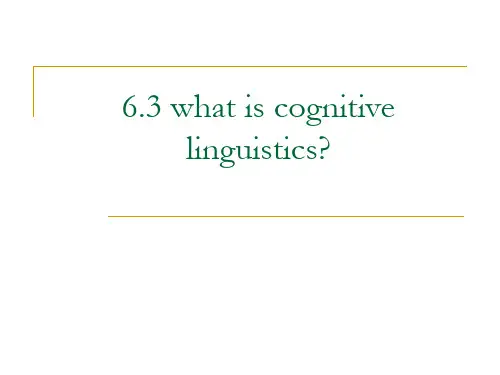
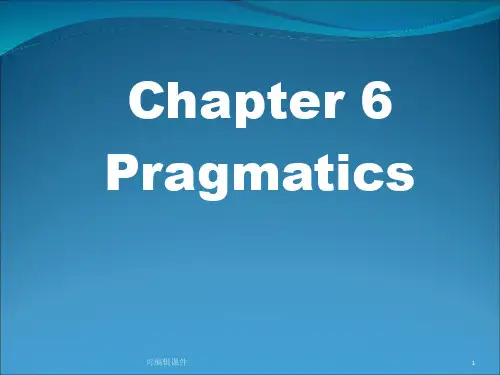
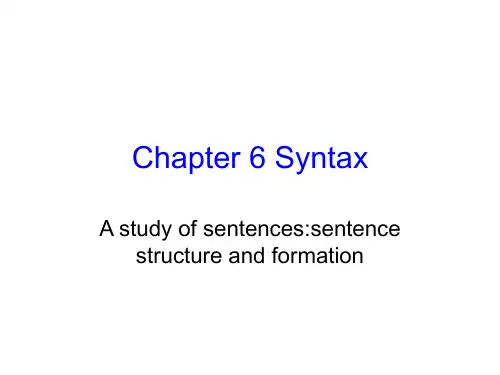
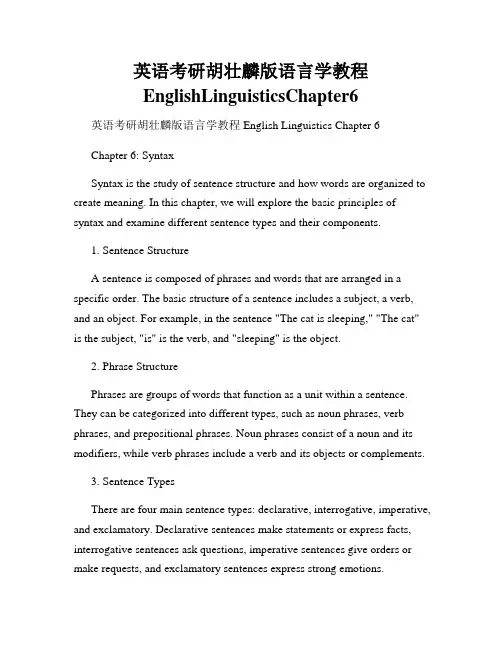
英语考研胡壮麟版语言学教程EnglishLinguisticsChapter6英语考研胡壮麟版语言学教程English Linguistics Chapter 6Chapter 6: SyntaxSyntax is the study of sentence structure and how words are organized to create meaning. In this chapter, we will explore the basic principles of syntax and examine different sentence types and their components.1. Sentence StructureA sentence is composed of phrases and words that are arranged in a specific order. The basic structure of a sentence includes a subject, a verb, and an object. For example, in the sentence "The cat is sleeping," "The cat" is the subject, "is" is the verb, and "sleeping" is the object.2. Phrase StructurePhrases are groups of words that function as a unit within a sentence. They can be categorized into different types, such as noun phrases, verb phrases, and prepositional phrases. Noun phrases consist of a noun and its modifiers, while verb phrases include a verb and its objects or complements.3. Sentence TypesThere are four main sentence types: declarative, interrogative, imperative, and exclamatory. Declarative sentences make statements or express facts, interrogative sentences ask questions, imperative sentences give orders or make requests, and exclamatory sentences express strong emotions.4. Sentence ComponentsIn addition to the basic subject-verb-object structure, sentences can also include other components such as adjectives, adverbs, and conjunctions. Adjectives modify nouns, adverbs modify verbs, and conjunctions connect words or phrases.5. Sentence TransformationsSyntax also involves the study of how sentences can be transformed or modified. Some common transformations include changing the word order, forming questions or negations, and using different sentence structures to convey the same meaning.6. Syntactic AnalysisSyntactic analysis is the process of examining the structure of a sentence to determine its grammatical correctness. It involves identifying the different parts of speech, analyzing phrase structures, and checking for agreement between words.7. Sentence ParsingSentence parsing is the process of breaking down a sentence into its constituent parts and determining the relationships between them. It helps in understanding the overall meaning of a sentence and how its components interact with each other.ConclusionSyntax plays a crucial role in understanding how sentences are structured and how meaning is created through word order and sentencetransformations. By studying the principles of syntax, we can gain a deeper understanding of the English language and enhance our language skills.Note: This article is written in a general format that is suitable for discussing the topic of syntax. The specific format of the "English Linguistics Chapter 6" would depend on the guidelines provided in the course materials.。

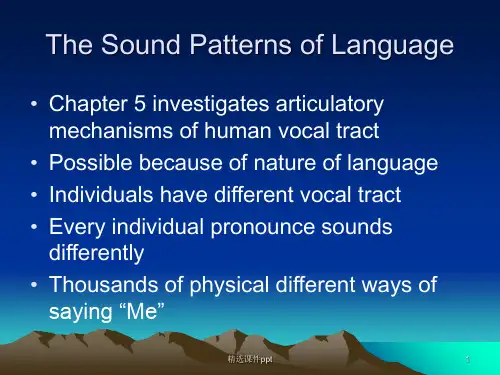
英语(yīnɡ yǔ)语言学概论第六章笔记Chapter 6 Pragmatics 语用学1.What is pragmatics?什么(shén me)是语用学?Pragmatics can be defined as the study of how speakers of a language use sentences to effect successful communication.As the process of communication is essentially a process of conveying meaning in a certain context, pragmatics can also be regarded as a kind of meaning study. It places the study of meaning in the context in which language is used.语用学研究(yánjiū)的是说某种语言的人怎样用句子去实现成功的交际。
由于交际的过程从本质来说是在一定的语境中表达意义的过程,因而语用学的本质是一种意义研究(yánjiū)。
它是一种将语言置于使用的语境中去的意义研究。
2.Pragmatics and semantics 语用学和语义学Pragmatics and semantics are both linguistic studies of meaning, but they are different. What essentially distinguishes semantics and pragmatics is whether in the study of meaning, the context of use is considered. If it is not considered, the study is restricted to the area of traditional semantics; if it is considered, the study is being carried out in the area of pragmatics.语用学和语义学都是对意义的语言学研究,但两者是不同(bù tónɡ)的。
Chapter 6 PRAGMATICS1. What does pragmatics study? How does it differ from traditional semantics?答:Generally speaking, pragmatics is the study of meaning in the context. It studies meaning in a dynamic way and as a process. In order to have a successful communication, the speaker and hearer must take the context into their consideration so as to effect the right meaning and intention. The development and establishment pragmatics in 1960s and 1970s resulted mainly from the expansion of the study semantics. However, it is different from the traditional semantics. The major difference between them lies in that pragmatics studies meaning in a dynamic way, while semantics studies meaning in a static way. Pragmatics takes context into consideration while semantics does not. Pragmatics takes care of the aspect of meaning that is not accounted for by semantics.2. Why is the notion of context essential in the pragmatic study of linguistic communication? 答:The notion of context is essential to the pragmatic study of language. It is generally considered as constituted by the knowledge shared by the speaker and the hearer. Various continents of shared knowledge have been identified, e.g. knowledge of the language they use, knowledge of what has been said before, knowledge about the world in general, knowledge about the specific situation in which linguistic communication is taking place, and knowledge about each other. Context determines the speaker's use of language and also the heater's interpretation of what is said to him. Without such knowledge, linguistic communication would not be possible, and without considering such knowledge, linguistic communication cannot be satisfactorily accounted for in a pragmatic sense. Look at the following sentences:(1) How did it go?(2) It is cold in hem.(3) It was a hot Christmas day so we went down to the beach in the afternoon and had agood time swimming and surfing.Sentence (1) might be used in a conversation between two students talking about an examination, or two surgeons talking about an operation, or in some other contexts; (2) might be said by the speaker to ask the hearer to turn on the heater, or leave the place, or to put on more clothes, or to apologize for the poor condition of the room, depending on the situation of context; (3) makes sense only ii the hearer has the knowledge that Christmas falls in summer in the southern hemisphere.3. How are sentence meaning and utterance meaning related, and how do they differ?答: A sentence is a grammatical concept, and the meaning of a sentence is often studied as the abstract, intrinsic property of the sentence itself in terms of predication. But if we think of a sentence as what people actually utter in the course of communication, it becomes an utterance, and it should be considered in the situation in which it is actually uttered (or used). So it is impossible to tell if “The dog is barking” is a sentence or an utterance. It can be either. It all depends on how we look at it and how we are going to analyze it. If we take it as a grammatical unit and consider it as a self-contained unit in isolation from context, then we are treating it as a sentence. If we take it as something a speaker utters in a certain situation with a certain purpose, then we are treating it as an utterance.Therefore, while the meaning of a sentence is abstract, and decontextualized, that of anutterance is concrete, and context-dependent. The meaning of an utterance is based on sentence meaning; it is the realization of the abstract meaning of a sentence in a real situation of communication, or simply in a context. Now, take the sentence "My bag is heavy" as an example. Semantic analysis of the meaning of the sentence results in the one-place predication BAG (BEING HEA VY). Then a pragmatic analysis of the utterance meaning of the .sentence varies with the context in which it is uttered. For example, it could be uttered by a speaker as a straightforward statement, telling the hearer that his bag is heavy. It could also be intended by the speaker as an indirect, polite request, asking the hearer to help him carry the bag. Another possibility is that the speaker is declining someone's request for help. All these are possible interpretations of the same utterance “M y bag is heavy”. How it is to be underst ood depends on the context in which it is uttered and the purpose for which the speaker utters it.While most utterances take the form of grammatically complete sentences, some utterances do not, and some cannot even be restored to complete sentences.4. Try to think of contexts in which the following sentences can be used for other purposes than just stating facts:a) The room is messy.b) Oh, it is raining!c) The music of the movie is good.d) You have been keeping my notes for a whole week now.答:a) A father entered his son’s room and found it is very messy. Then when he said, “The room is messy,” he was blaming his son for not tidying it up.b) A son asked his father to play with him outside. So when the father said, “Oh, it’s raining”,he meant they couldn’t play outside.c) Two persons just watched a movie and had a discussion of it. One person sai d, “The story ofthe movie is very moving”, so wh en the other person sai d, “The music of the movie is good”, he me ant he didn't think the story of the movie was good.d) A person wanted his notes bac k, so when he said, “you ha ve been keeping my notes for awhole wee k now”, he was demanding the return of his notes.5. According to Austin, what are the three acts a person is possibly performing while making an utterance. Give an example.答:According to Austin's new model, a speaker might be performing three acts simultaneously when speaking: locutionary act, illocutionary act, and perlocutionary act.A locutionary act is the act of uttering words, phrases, clauses. It is the act of conveying literal meaning by means of syntax, lexicon and phonology. An illocutionary act is the act of expressing the speaker’s intention; it is the act performed in saying something. A perlocutionary act is the act performed by or resulting from saying something; it is the consequence of, or the change brought about by the utterance; it is the act performed by saying something. Let's look at an example:You have left the door wide open.The locutionary act performed by the speaker is his utterance of the wo rds “you”, “have”, “door”, “open”, etc. thus expressing what the words literally mean.The illocutionary act performed by the speaker is that by making such an utterance he has expressed his intention of speaking, i.e. asking someone to close the door, or making acomplaint, depending on the context.The perlocutionary act refers to the effect of the utterance. If the hearer gets the speaker's message and sees that the speaker means to tell him to close the door, the speaker has successfully brought about the change in the real world he has intended to; then the perlocutionary act is successfully performed.6. What are the five types of illocutionary speech acts Searle has specified? What is theillocutionary point of each type?答:(1) representatives: stating or describing, saying what the speaker believes to be true(2) directives: trying to get the hearer to do something(3) commissives: committing the speaker himself to some future course of action(4) expressives: expressing feelings or attitude towards an existing(5) declarations: bringing about immediate changes by saying somethingThe illocutionary point of the representatives is to commit the speaker to something's being the case, to the truth of what has been said, in other words, when performing an illocutionary act of representative, the speaker is making a statement or giving a description which he himself believes to be true. Stating, believing, sweating, hypothesizing are among the most typical of the representatives.Directives ate attempts by the speaker to get the hearer to do some- thing. Inviting, suggesting, requesting, advising, wanting, threatening and ordering are all specific instances of this class.Commissives are those illocutionary acts whose point is to commit the speaker to some future course of action, i.e. when speaking the speaker puts himself under a certain obligation. Promising, undertaking, vowing are the most typical ones.The illocutionary point of expressives is to express the psychological state specified in the utterance. The speaker is expressing his feelings or attitudes towards an existing state of affairs, e.g. apologizing, thanking, congratulating.The last class “declarations” has the characteristic that the successful performance of an act of this type brings about the correspondence between what is said and reality.7. What is indirect language use? How is it explained in the light of speech act theory?答:When someone is not saying I an explicit and straightforward manner what he means to say, rather he is trying to put across his message in an implicit, roundabout way, we can say he is using indirect language.Explanation (略) (见教材p.84-85)8. What are the four maxims of the CP? Try to give your own examples to show how floutingthese maxims gives rise to conversational implicature?答:Cooperative Principle, abbreviated as CP. It goes as follows:Make your conversational contribution such as required at the stage at which it occurs by the accepted purpose or direction of the talk exchange in which you are engaged.To be more specific, there are four maxims under this general principle:(1) The maxim of quantity①Make your contribution as informative as required (for the current purpose of theexchange).②Do not make your contribution more informative than is required.(2) The maxim of quality①Do not say what you believe to be false.②Do not say that for which you lack adequate evidence.(3) The maxim of relationBe relevant.(4) The maxim of manner①Avoid obscurity of expression.②Avoid ambiguity.③Be brief (avoid unnecessary prolixity).④Be orderly.9. What is pragmatic failure? Try to find instances of pragmatic failure in the English usedby Chinese learners of English.答:The technical term for breakdowns in the course of communication is pragmatic failure.Pragmatic failure occurs when the speaker fails to use language effectively to achieve a specific communication purpose, or when the hearer fails to recognize the intention or the illocutionary force of the speaker’s utterance in the context of communication.Instances (略) (见教材p.89)。